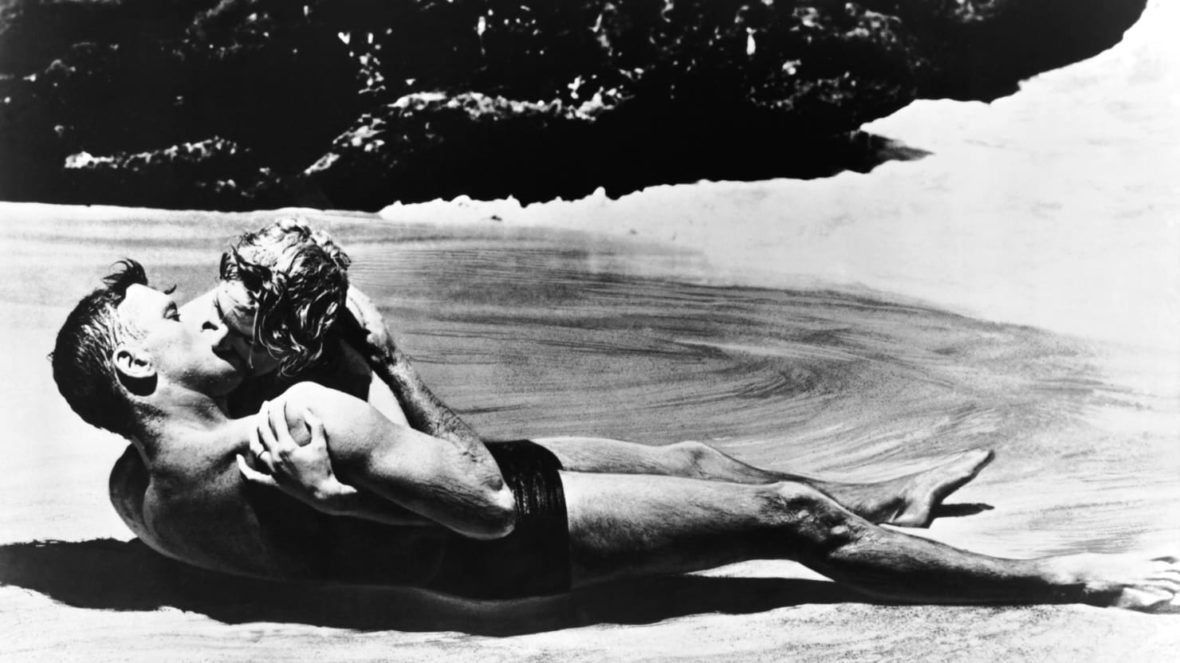From Here to Eternity is a 1953 drama movie directed by Fred Zinnemann and written by Daniel Taradash, based on the novel of the same name by James Jones. The movie is about the tribulations of three U.S. Army soldiers, played by Burt Lancaster, Montgomery Clift, and Frank Sinatra, stationed on Hawaii in the months leading up to the attack on Pearl Harbor. Take a look below for 30 more fun and fascinating facts about From Here to Eternity.
1. From Here to Eternity won 8 Academy Awards out of 13 nominations, including awards for Best Picture, Best Director, Adapted Screenplay, Supporting Actor and Supporting Actress.
2. The movie’s title originally comes from a quote from Rudyard Kipling’s 1892 poem “Gentlemen-Rankers,” about soldiers of the British Empire who had, “lost [their] way” and were “damned from here to eternity.”
3. In 2002, From Here to Eternity was selected for preservation in the National Film Registry by the Library of Congress as being, “culturally, historically, or aesthetically significant.”
4. Deborah Kerr and Burst Lancaster were romantically involved during filming.
5. The now classic scene between Burt Lancaster and Deborah Kerr in the rushing water on the beach wasn’t written to take place there. The idea to film with the waves hitting them was a last minute inspiration from director Fred Zinnemann.
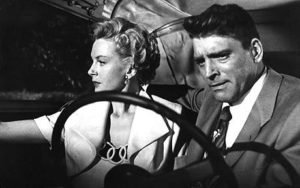
6. The MPAA banned photos of the famous Burt Lancaster-Deborah Kerr passionate kiss on the beach for being too erotic. Many prints had shortened versions of the scene because projectionists would cut out frames to keep as souvenirs.
7. The scene in which Maggio meets Prew and Lorene in the bar after he walks off guard duty, was actually Frank Sinatra’s screen test for the part of Maggio. To impress director Fred Zinnemann, he did an ad-lib using olives as dice and pretending to shoot craps. The entire sequence was kept as is and used in the picture.
8. Montgomery Clift, Frank Sinatra and author James Jones were very close during the filming, frequently embarking on epic drinking binges. Clift coached Sinatra on how to play Maggio during their more sober moments, for which Sinatra was eternally grateful.
9. In the scene where Burt Lancaster and Montgomery Clift play drunk sitting on the street, Clift was actually drunk, but Lancaster wasn’t.
10. Harry Cohn resisted the idea of casting Montgomery Clift as Prewitt as, “he was no soldier, no boxer and probably a homosexual.” However, Fred Zinnemann refused to make the movie without him.
11. The censors demanded that Deborah Kerr’s swimsuit should have a skirt in its design so as to not be too sexually provocative.
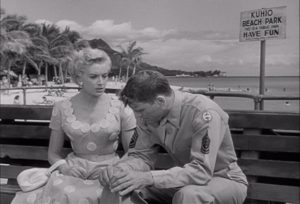
12. In the bar scene where Maggio asks Prewitt for a cigarette, he says, “gimme a nail.” A nail was a nail for his coffin. This was a common expression popular at the time that referred to the health hazards from smoking.
13. A nationwide search of army surplus stores yielded pre-Pearl Harbor-style Springfield rifles, canvas leggings, campaign hats and flat steel helmets. The extras, who were all real soldiers, were all drilled to learn how to use all of the outdated equipment.
14. From Here to Eternity is often credited with popularizing Aloha shirts.
15. Censorship at the time meant that Donna Reed’s character was never referenced as a prostitute, but as a nightclub hostess.
16. Frank Sinatra has personal problems of his own. The collapse of his marriage to Ava Gardner weighed heavily on him. It got so bad that he told Montgomery Clift one night that he was going to kill himself.
17. Burt Lancaster was so nervous about acting alongside Montgomery Clift that he was physically shaking in their first scene together.
18. From Here to Eternity was shot in just 41 days and for only $1 million.
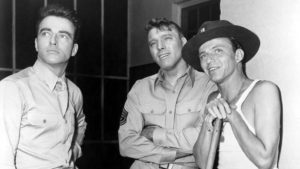
19. James Jones, who wrote the novel on which the movie was based on, wasn’t happy with the movie, considering it to be too sanitized.
20. Montgomery Clift didn’t manage to move like a boxer despite extensive boxing lessons, so he had to be doubled by a real boxer for the long shots in the boxing match. The fight had to be carefully edited so the close-ups and other shots matched. However, the use of the double is obvious if you pay attention to the details.
21. At the time of the original novel’s release, it was dubbed “From Here to Obscenity” because of its frank content and profane language. The book was banned in libraries across the United States for years.
22. Donna Reed remembered Montgomery Clift’s concentration as being, “positively violent.”
23. The U.S. Army was initially reluctant to lend their co-operation to the production. However, producer Buddy Adler had been a Lieutenant Colonel in the Signal Corps during World War II and was able to bring his influence to bear.
24. Burt Lancaster was nervous when he started the film. Most of his previous work had been fairly lightweight productions, and this was one of his first serious roles, along with Come Back, Little Sheba. He was especially intimidated by Montgomery Clift’s skill and intensity.
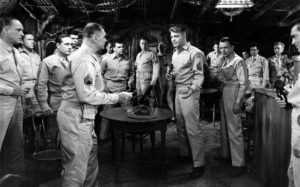
25. Montgomery Clift had difficulty letting the character of Prewitt go after filming was completed and would often turn up drunk in Hollywood bars and clubs with his bugle and Hawaiian shirts.
26. Fred Zinnemann insisted on filming in black and white, as he felt that, “color would have made it look trivial.” He also eschewed the use of any of the popular new widescreen ratios.
27. Fred Zinnemann hated filming the scene where Captain Holmes is forced to resign from the army, as he felt it seemed like a recruiting drive for the army.
28. To keep from overrunning Harry Cohn’s 120 minute dictate, Fred Zinnemann was forced to forego some scenes he particularly prized. One was a scene near the end where Prewitt mistakenly believes that Pearl Harbor is being attacked by the Germans.
29. Frank Sinatra had to campaign hard to get his part as his career had hit a low point by the time.
30. James Jones sold an extra 2 million copies of his book off the back of the movie’s success.

